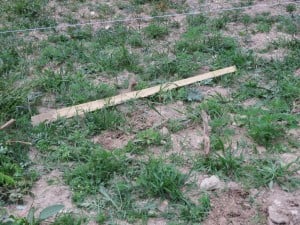In July, at the Appalachian South Folklife Center, we built a small hugelkultur bed and seeded it with Buckwheat. I had never heard of hugelkultur before David Williams, came from North Carolina to give a permaculture workshop here on soil building. I am really into the idea of raised beds and no- till methods and I have been watching the hugelkultur bed closely, intrigued at how it will break down and produce.

This is what we started with. The soil had been plowed a month earlier. Grass, queen annes lace and some type of thistle was growing the best in this soil.
Hugelkultur is a permaculture method of building garden beds. The idea is to pile woody debris (branches and stumps on the bottom and smaller twigs on top) and then cover it with green clippings, manure and dirt. The pile breaks down creating a moisture-holding yet well-draining garden bed.
The wood at the bottom of the bed mimics natures systems by soaking up water like a sponge and releasing it slowly to the surrounding soil and plants.
You can make your hugelkultur pile as high as you want (remember it will break down and shrink). I read that 3 feet was considered a premium heightto start and we aimed for that, but I saw pictures of taller ones and read accounts of gardeners using this method to make beds that were waist high for easy gardening on older backs and knees.
To Recap, to make a hugelkultur bed you really only need:
- Wood
- Nitrogen rich material (compost, manure, pulled weeds)
- Topsoil to cover the bed- one to two inches is probably fine.
- Water the whole thing afterwards and in between steps.

One month later, the buckwheat is growing, there’s a little bit of erosion where our pile could have been better. See how its already shrunk!!
Buckwheat is a great cover crop because it is fast to establish and mature (70-90 days). It encourages beneficial insects and pollinators with its many blossoms and it extracts soil phosphorus better than other cover crops. It is frost sensitive and easy to kill. I really like the way it looks too- it’s so easy to grow and it looks lush even in this setting!

Two months later the buckwheat is flowering and toppling. You can still see our problem erosion area but the bed is overall vibrant and functional!
This fall, the buckwheat will die and its’ residue will cover the bed. In the spring we will plant into it again and see how it progresses!
For more information on hugelkultur beds:
The art and science of making a hugelkultur bed
Many benefits of Hugelkultur (lots of great pictures!!)






Leave A Comment